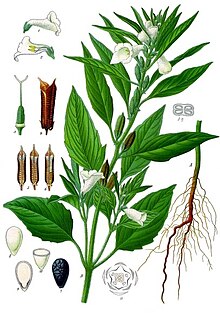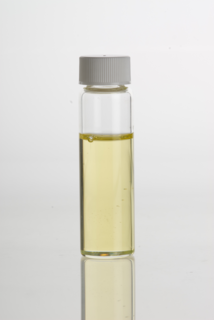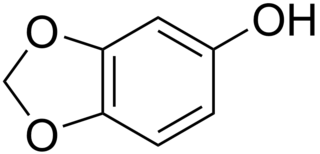
Sesame is a flowering plant in the genus Sesamum, also called benne. Numerous wild relatives occur in Africa and a smaller number in India. It is widely naturalized in tropical regions around the world and is cultivated for its edible seeds, which grow in pods. World production in 2018 was 6 million tonnes, with Sudan, Myanmar, and India as the largest producers.

Sesame oil is an edible vegetable oil derived from sesame seeds. Besides being used as a cooking oil, it is used as a flavor enhancer in many cuisines, having a distinctive nutty aroma and taste. The oil is one of the earliest-known crop-based oils. Worldwide mass modern production is limited due to the inefficient manual harvesting process required to extract the oil. In the Akkadian language it was called Ellu.

Cedrus deodara, the deodar cedar, Himalayan cedar, or deodar/ devdar/ devadar/ devadaru, is a species of cedar native to the western Himalayas in Eastern Afghanistan, Northern Pakistan, and India, Southwestern Tibet, and Western Nepal occurring at 1,500–3,200 m (4,921–10,499 ft) altitude.
![Secoisolariciresinol diglucoside Antioxidant[1] phytoestrogen present in flax, sunflower, sesame, and pumpkin seeds. In food, it can be found in commercial breads containing flaxseed](https://upload.wikimedia.org/wikipedia/commons/thumb/b/b2/Secoisolarisiresinol_diglucoside.svg/320px-Secoisolarisiresinol_diglucoside.svg.png)
Secoisolariciresinol diglucoside (SDG) is an antioxidant phytoestrogen present in flax, sunflower, sesame, and pumpkin seeds. In food, it can be found in commercial breads containing flaxseed. It is a precursor of mammal lignans which are produced in the colon from chemicals in foods.
The lignans are a large group of low molecular weight polyphenols found in plants, particularly seeds, whole grains, and vegetables. The name derives from the Latin word for "wood". Lignans are precursors to phytoestrogens. They may play a role as antifeedants in the defense of seeds and plants against herbivores.

Sesamol is a natural organic compound which is a component of sesame seeds and sesame oil. It is a white crystalline solid that is a derivative of phenol. It is sparingly soluble in water, but miscible with most oils. It can be produced by organic synthesis from heliotropine.

Matairesinol is an organic compound. It is classified as a lignan, i.e., a type of phenylpropanoid. It is present in some cereals, e.g. rye, and together with Secoisolariciresinol, has attracted much attention for its beneficial nutritional effects.

Arctigenin is a lignan found in certain plants of the Asteraceae, including the greater burdock and Saussurea heteromalla. It has shown antiviral and anticancer effects in vitro. It is the aglycone of arctiin.

Leukotriene-B(4) omega-hydroxylase 1 is an enzyme protein involved in the metabolism of various endogenous substrates and xenobiotics. The most notable substrate of the enzyme is leukotriene B4, a potent mediator of inflammation. The CYP4F2 gene encodes the enzyme in humans.
Alkylpyrazines are chemical compounds based on pyrazine with different substitution patterns. Some alkylpyrazines are naturally occurring highly aromatic substances which often have a very low odor threshold and contribute to the taste and aroma of various foods including cocoa, baked goods, coffee and wines. Alkylpyrazines are also formed during the cooking of some foods via Maillard reactions.

Sesamin is a lignan isolated from the bark of Fagara plants and from sesame oil. It has been used as a dietary fat-reduction supplement, although no controlled studies on this application have been performed. Its major metabolite is enterolactone, which has an elimination half life of less than 6 hours. Sesamin and sesamolin are minor components of sesame oil, on average comprising only 0.14% of the oil by mass.

Yakgwa, also called gwajul (과줄), is a type of yumil-gwa, which is deep-fried, wheat-based hangwa made with honey, cheongju, sesame oil, and ginger juice. Traditionally, the sweet was offered in a jesa and enjoyed on festive days such as chuseok, marriages, or hwangap (sixtieth-birthday) celebrations. In modern South Korea, it is also served as a dessert and can be bought at traditional markets or supermarkets.
The molecular formula C20H18O6 (molar mass: 354.35 g/mol, exact mass: 354.110338 u) may refer to:

Lariciresinol is a lignan, i.e., a type of phenylpropanoids. It is the precursor to enterolignans by the action of gut microflora. Enterolignans are of interest because they are speculated to exhibit beneficial medicinal properties.

Enterolactone is a organic compound classified as an enterolignan. It is formed by the action of intestinal bacteria on plant lignan precursors present in the diet.
![Enterodiol Lignan formed by the action of intestinal bacteria on lignan precursors found in plants.[1]](https://upload.wikimedia.org/wikipedia/commons/thumb/e/eb/Enterodiol.png/320px-Enterodiol.png)
Enterodiol is an organic compound with the formula [HOC6H4CH2CH(CH2OH)]2.

Pinoresinol is a lignan found in Styrax sp. and in Forsythia suspensa. It is also found in the caterpillar of the cabbage butterfly, Pieris rapae where it serves as a defence against ants.

In agriculture, shattering is the dispersal of a crop's seeds upon their becoming ripe. From an agricultural perspective this is generally an undesirable process, and in the history of crop domestication several important advances have involved a mutation in a crop plant that reduced shattering—instead of the seeds being dispersed as soon as they were ripe, the mutant plants retained the seeds for longer, which made harvesting much more effective. Non-shattering phenotype is one of the prerequisites for plant breeding especially when introgressing valuable traits from wild varieties of domesticated crops.

Gomisin A is a bio-active compound isolated from Schisandra chinensis.

Chili oil is a condiment made from vegetable oil that has been infused with chili peppers. Different types of oil and hot peppers are used, and other components may also be included. It is commonly used in Chinese cuisine, East and Southeast Asia and elsewhere. Particularly popular in Sichuan cuisine, Hunan cuisine, and Shaanxi cuisine it is used as an ingredient in cooked dishes as well as a condiment. It is sometimes used as a dip for meat and dim sum. It is also employed in the Korean Chinese noodle soup dish jjamppong.




![Secoisolariciresinol diglucoside Antioxidant[1] phytoestrogen present in flax, sunflower, sesame, and pumpkin seeds. In food, it can be found in commercial breads containing flaxseed](https://upload.wikimedia.org/wikipedia/commons/thumb/b/b2/Secoisolarisiresinol_diglucoside.svg/320px-Secoisolarisiresinol_diglucoside.svg.png)








![Enterodiol Lignan formed by the action of intestinal bacteria on lignan precursors found in plants.[1]](https://upload.wikimedia.org/wikipedia/commons/thumb/e/eb/Enterodiol.png/320px-Enterodiol.png)



